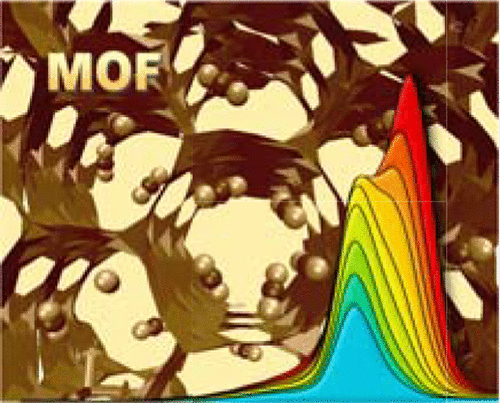当前位置:
X-MOL 学术
›
Chem. Rev.
›
论文详情
Our official English website, www.x-mol.net, welcomes your
feedback! (Note: you will need to create a separate account there.)
Power of Infrared and Raman Spectroscopies to Characterize Metal-Organic Frameworks and Investigate Their Interaction with Guest Molecules
Chemical Reviews ( IF 51.4 ) Pub Date : 2020-12-14 , DOI: 10.1021/acs.chemrev.0c00487 Konstantin I. Hadjiivanov 1 , Dimitar A. Panayotov 1 , Mihail Y. Mihaylov 1 , Elena Z. Ivanova 1 , Kristina K. Chakarova 1 , Stanislava M. Andonova 1 , Nikola L. Drenchev 1
Chemical Reviews ( IF 51.4 ) Pub Date : 2020-12-14 , DOI: 10.1021/acs.chemrev.0c00487 Konstantin I. Hadjiivanov 1 , Dimitar A. Panayotov 1 , Mihail Y. Mihaylov 1 , Elena Z. Ivanova 1 , Kristina K. Chakarova 1 , Stanislava M. Andonova 1 , Nikola L. Drenchev 1
Affiliation

|
The variety of functionalities and porous structures inherent to metal-organic frameworks (MOFs) together with the facile tunability of their properties makes these materials suitable for a wide range of existing and emerging applications. Many of these applications are based on processes involving interaction of MOFs with guest molecules. To optimize a certain process or successfully design a new one, a thorough knowledge is required about the physicochemical characteristics of materials and the mechanisms of their interaction with guest molecules. To obtain such important information, various complementary analytical techniques are applied, among which vibrational spectroscopy (IR and Raman) plays an important role and is indispensable in many cases. In this review, we critically examine the reported applications of IR and Raman spectroscopies as powerful tools for initial characterization of MOF materials and for studying processes of their interaction with various gases. Both the advantages and the limitations of the technique are considered, and the cases where IR or Raman spectroscopy is preferable are highlighted. Peculiarities of MOFs interaction with specific gases and some inconsistent band assignments are also emphasized. Summarizing the broad analytical possibilities of the IR and Raman spectroscopies, we conclude that it can be applied in combinations with other techniques to explicitly establish the structure, properties, and reactivity of MOFs.
中文翻译:

红外和拉曼光谱法表征金属有机骨架并研究其与客体分子相互作用的能力
金属有机骨架(MOF)固有的各种功能和多孔结构,以及其特性的便捷可调性,使这些材料适用于广泛的现有和新兴应用。这些应用中的许多都是基于涉及MOF与客体分子相互作用的过程的。为了优化某个过程或成功设计一个新过程,需要对材料的物理化学特性及其与客体分子相互作用的机理有透彻的了解。为了获得这样的重要信息,应用了各种互补的分析技术,其中振动光谱法(IR和拉曼光谱仪)起着重要的作用,并且在许多情况下是必不可少的。在这篇评论中 我们严格审查了IR和拉曼光谱学的报道应用,将其作为MOF材料的初始表征和研究其与各种气体相互作用过程的有力工具。考虑到该技术的优点和局限性,重点介绍了红外或拉曼光谱法更可取的情况。还强调了MOF与特定气体相互作用的特殊性以及一些不一致的谱带分配。总结了IR和拉曼光谱学的广泛分析可能性,我们得出结论,可以将其与其他技术结合使用,以明确建立MOF的结构,性质和反应性。考虑到该技术的优点和局限性,重点介绍了红外或拉曼光谱法更可取的情况。还强调了MOF与特定气体相互作用的特殊性以及一些不一致的谱带分配。总结了IR和拉曼光谱学的广泛分析可能性,我们得出结论,可以将其与其他技术结合使用,以明确建立MOF的结构,性质和反应性。考虑到该技术的优点和局限性,重点介绍了红外或拉曼光谱法更可取的情况。还强调了MOF与特定气体相互作用的特殊性以及一些不一致的谱带分配。总结了IR和拉曼光谱学的广泛分析可能性,我们得出结论,可以将其与其他技术结合使用,以明确建立MOF的结构,性质和反应性。
更新日期:2021-02-10
中文翻译:

红外和拉曼光谱法表征金属有机骨架并研究其与客体分子相互作用的能力
金属有机骨架(MOF)固有的各种功能和多孔结构,以及其特性的便捷可调性,使这些材料适用于广泛的现有和新兴应用。这些应用中的许多都是基于涉及MOF与客体分子相互作用的过程的。为了优化某个过程或成功设计一个新过程,需要对材料的物理化学特性及其与客体分子相互作用的机理有透彻的了解。为了获得这样的重要信息,应用了各种互补的分析技术,其中振动光谱法(IR和拉曼光谱仪)起着重要的作用,并且在许多情况下是必不可少的。在这篇评论中 我们严格审查了IR和拉曼光谱学的报道应用,将其作为MOF材料的初始表征和研究其与各种气体相互作用过程的有力工具。考虑到该技术的优点和局限性,重点介绍了红外或拉曼光谱法更可取的情况。还强调了MOF与特定气体相互作用的特殊性以及一些不一致的谱带分配。总结了IR和拉曼光谱学的广泛分析可能性,我们得出结论,可以将其与其他技术结合使用,以明确建立MOF的结构,性质和反应性。考虑到该技术的优点和局限性,重点介绍了红外或拉曼光谱法更可取的情况。还强调了MOF与特定气体相互作用的特殊性以及一些不一致的谱带分配。总结了IR和拉曼光谱学的广泛分析可能性,我们得出结论,可以将其与其他技术结合使用,以明确建立MOF的结构,性质和反应性。考虑到该技术的优点和局限性,重点介绍了红外或拉曼光谱法更可取的情况。还强调了MOF与特定气体相互作用的特殊性以及一些不一致的谱带分配。总结了IR和拉曼光谱学的广泛分析可能性,我们得出结论,可以将其与其他技术结合使用,以明确建立MOF的结构,性质和反应性。











































 京公网安备 11010802027423号
京公网安备 11010802027423号